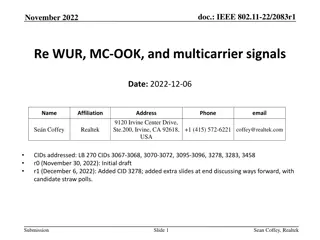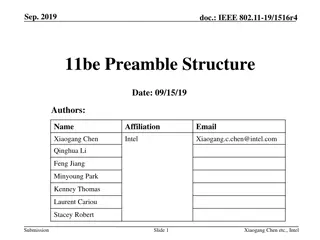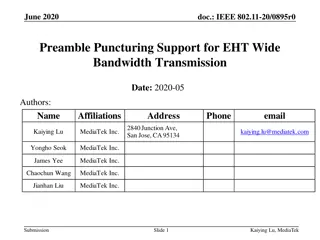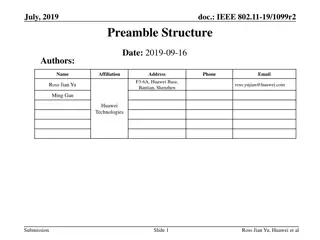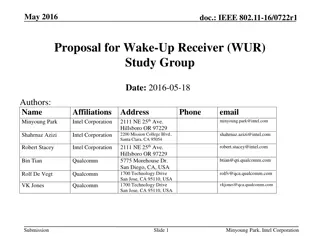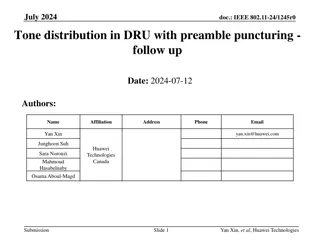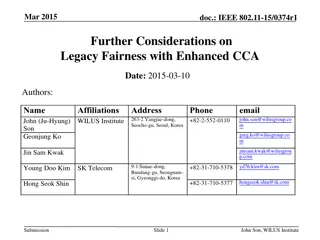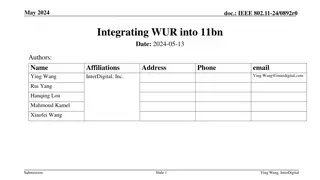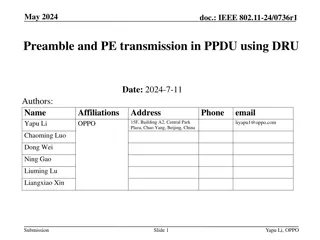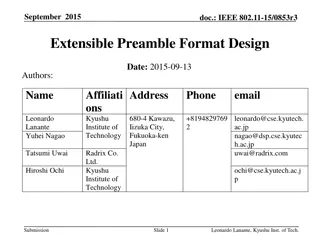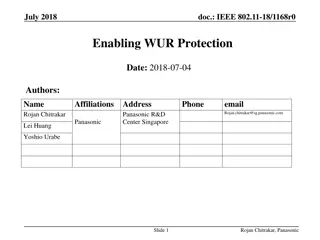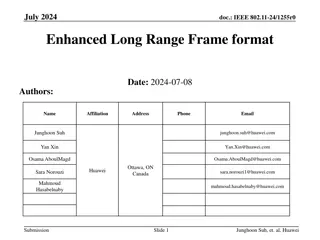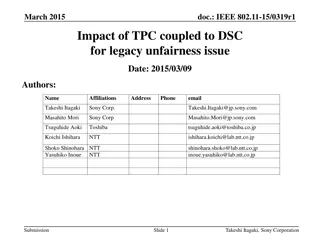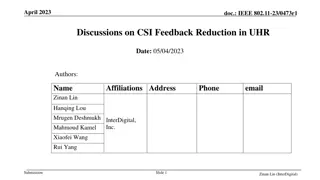
Legacy Preamble Design for IEEE 802.11 Wake-up Radio
Explore legacy preamble design challenges and proposed solutions for Wake-up Radio in IEEE 802.11 devices to ensure compatibility and efficient CCA settings. Solutions include spoofing mechanisms and simulation settings for optimal performance.
Download Presentation

Please find below an Image/Link to download the presentation.
The content on the website is provided AS IS for your information and personal use only. It may not be sold, licensed, or shared on other websites without obtaining consent from the author. If you encounter any issues during the download, it is possible that the publisher has removed the file from their server.
You are allowed to download the files provided on this website for personal or commercial use, subject to the condition that they are used lawfully. All files are the property of their respective owners.
The content on the website is provided AS IS for your information and personal use only. It may not be sold, licensed, or shared on other websites without obtaining consent from the author.
E N D
Presentation Transcript
May 2017 doc.: IEEE 802.11-17/0647r4 WUR Legacy Preamble Design Date: 2017-05-07 Authors: Name Rui Cao Affiliations Marvell Address 5488 Marvell Ln, Santa Clara, CA 95054 Phone email ruicao@marvell.com hongyuan@marvell.com Hongyuan Zhang Marvell Hua Mu Marvell hmu@marvell.com Submission Slide 1 Rui Cao, Marvell
May 2017 doc.: IEEE 802.11-17/0647r4 Introduction Wake-up Radio (WUR) frame is designed to be compatible with other 802.11 devices to correctly set CCA and backoff. A simple design is to append 802.11 legacy preambles to the WUR packet, the same as HT mixed mode/VHT/HE packet format If WUR symbol adopts narrow-band design, for example 4MHz [1], the legacy preamble portion preceding WUR symbols may trigger 802.11n devices to false detect WUR packet to be a 11n type, and erroneously set the PHY- CCA.indication(IDLE) To address this issue, several design options are proposed Submission Slide 2 Rui Cao, Marvell
May 2017 doc.: IEEE 802.11-17/0647r4 802.11n Device Rx State Machine As show in IEEE 802.11mc standards [2], if HT-SIG CRC fails, the PHY- CCA.indication(IDLE) is set when receive level drops below threshold. Submission Slide 3 Rui Cao, Marvell
May 2017 doc.: IEEE 802.11-17/0647r4 WUR Packet Format LSTF LLTF LSIG WUR Preamble WUR Payload Legacy preambles: LSTF+LLTF+LSIG, needs to be added to spoof 802.11 devices for CCA The popular WUR preamble design is based on narrow band (e.g. 4MHz) signaling [1] The unpopulated tones in the WUR portion will be received as noise with random phase For WiFi devices supporting up to 802.11n, the auto detection mechanism may false detect the WUR packet as 11n packet with higher probability. Need a design to spoof 802.11n devices to correct set CCA Submission Slide 4 Rui Cao, Marvell
May 2017 doc.: IEEE 802.11-17/0647r4 Proposed Solutions 4us Symbol WUR Preamble WUR Payload LSTF LLTF LSIG Solution: add a dummy 4us OFDM symbol with BPSK modulation before narrow-band WUR preamble. This symbol is designed solely to spoof 802.11n device This OFDM symbol could be a 4-us LLTF, or any other BPSK modulated 20MHz OFDM symbol. WUR STA will start WUR packet reception after this symbol Negligible impact on the WUR preamble processing and packet reception Submission Slide 5 Rui Cao, Marvell
May 2017 doc.: IEEE 802.11-17/0647r4 Simulation Settings Packet: WUR with LSTF + LLTF + LSIG + WUR Portion WUR Portion bandwidth: 4MHz signal WUR Portion modulation: OOK 20MHz Rx sampling Impairments: Tx/Rx IQ imbalance, Tx/Rx Phase Noise Using 11ax design parameters WUR Rx will have worse impairments No CFO Submission Slide 6 Rui Cao, Marvell
May 2017 doc.: IEEE 802.11-17/0647r4 Channel AWGN 1x1,AWGN 0 10 4MHz-WUR 20MHz-BPSK -1 10 Pfalse -2 10 -3 10 -4 -2 0 2 4 6 8 SNR(dB) Submission Slide 7 Rui Cao, Marvell
May 2017 doc.: IEEE 802.11-17/0647r4 Channel D 1x1,DNLos 0 10 4MHz-WUR 20MHz-BPSK -1 10 Pfalse -2 10 -3 10 -4 -2 0 2 4 6 8 SNR(dB) Submission Slide 8 Rui Cao, Marvell
May 2017 doc.: IEEE 802.11-17/0647r4 UMi-LOS 1x1, UMi-Los 0 10 4MHz-WUR 20MHz-BPSK -1 10 Pfalse -2 10 -3 10 -4 -2 0 2 4 6 8 SNR(dB) Submission Slide 9 Rui Cao, Marvell
May 2017 doc.: IEEE 802.11-17/0647r4 Discussions-1 The 4MHz narrow band signal may typically degrade the 11n device QBPSK detection by 3+ dB in fading channels based on one particular QBPSK detection method. Existing 11n devices may have various methods of doing QBPSK classification, therefore it is hard to design a 4MHz signal spoofing ALL existing 11n devices reliably. Submission Slide 10 Rui Cao, Marvell
May 2017 doc.: IEEE 802.11-17/0647r4 Discussions-2 The 802.11n device spoofing can also be achieved with MAC options by transmitting CTS-to-self before each WUR packet for proper protection There are several disadvantages of this MAC solution High communication overhead No former example of MAC solution for format protection The exception is 11n green-field packet, but gets little industry adoption For the extra BPSK symbol design, we may not need standardize the content of the symbol as long as it is BPSK modulated Submission Slide 11 Rui Cao, Marvell
May 2017 doc.: IEEE 802.11-17/0647r4 Conclusions 802.11n device may have high false alarm probability for WUR packets This issue can be addressed with PHY design by adding an extra BPSK modulated OFDM symbol before narrow-band WUR symbol Submission Slide 12 Rui Cao, Marvell
May 2017 doc.: IEEE 802.11-17/0647r4 Straw Poll 1 Do you agree to have L-STF, L-LTF, and L-SIG appended in 11ba packets, and add an extra full-bandwidth (20MHz) OFDM symbol with BPSK modulation after LSIG in the 11ba packets to spoof legacy devices? Yes No Abstain Submission Slide 13 Rui Cao, Marvell
May 2017 doc.: IEEE 802.11-17/0647r4 Motion-1 Move to add the followings into SFD: A 20MHz non-HT preamble is prepended in any WUR PPDU, including L-STF, L-LTF and L-SIG fields. A 20MHz OFDM symbol, with tone spacing 312.5KHz and BPSK, and of duration 4us, is present immediately after the L-SIG field and right before the narrow band portion of any WUR PPDU. Mover: Hongyuan Zhang Seconder: Tianyu Wu Submission Slide 14 Rui Cao, Marvell
March 2017 doc.: IEEE 802.11-17/0647r4 References [1] Minyoung Park et al., LP-WUR (Low-Power Wake-Up Receiver) Follow-Up , IEEE 802.11-16/0341r0, Mar. 14, 2016. [2] IEEE draft P802.11REVmc_D8.0.pdf Submission Slide 15 Rui Cao, Marvell

